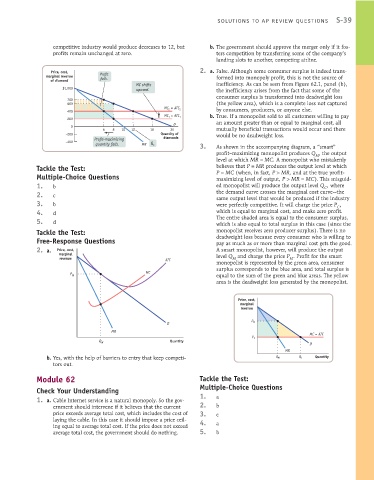Page 885 - Krugmans Economics for AP Text Book_Neat
P. 885
S-39
SOLUTIONS TO AP REVIEW QUESTIONS
competitive industry would produce decreases to 12, but b. The government should approve the merger only if it fos-
profits remain unchanged at zero. ters competition by transferring some of the company’s
landing slots to another, competing airline.
Price, cost, 2. a. False. Although some consumer surplus is indeed trans-
marginal revenue Profit formed into monopoly profit, this is not the source of
of diamond falls.
MC shifts inefficiency. As can be seen from Figure 62.1, panel (b),
$1,000
upward. the inefficiency arises from the fact that some of the
consumer surplus is transformed into deadweight loss
700
600 (the yellow area), which is a complete loss not captured
MC 2 = ATC 2
400 by consumers, producers, or anyone else.
MC 1 = ATC 1 b. True. If a monopolist sold to all customers willing to pay
200
D an amount greater than or equal to marginal cost, all
0
6 8 10 12 16 20 mutually beneficial transactions would occur and there
–200 Quantity of would be no deadweight loss.
Profit-maximizing diamonds
–400
quantity falls. MR Q C 3. As shown in the accompanying diagram, a “smart”
profit–maximizing monopolist produces Q , the output
M
level at which MR = MC. A monopolist who mistakenly
Tackle the Test: believes that P = MR produces the output level at which
Multiple-Choice Questions P = MC (when, in fact, P > MR, and at the true profit-
maximizing level of output, P > MR = MC). This misguid-
1. b ed monopolist will produce the output level Q , where
C
2. c the demand curve crosses the marginal cost curve—the
3. b same output level that would be produced if the industry
were perfectly competitive. It will charge the price P ,
C
4. d which is equal to marginal cost, and make zero profit.
5. d The entire shaded area is equal to the consumer surplus,
which is also equal to total surplus in this case (since the
Tackle the Test: monopolist receives zero producer surplus). There is no
Free-Response Questions deadweight loss because every consumer who is willing to
pay as much as or more than marginal cost gets the good.
2. a. Price, cost, A smart monopolist, however, will produce the output
marginal
revenue ATC level Q and charge the price P . Profit for the smart
M
M
monopolist is represented by the green area, consumer
surplus corresponds to the blue area, and total surplus is
MC
P
M equal to the sum of the green and blue areas. The yellow
area is the deadweight loss generated by the monopolist.
Price, cost,
marginal
revenue
D P M
MR
MC = ATC
P C
Q M Quantity D
MR
b. Yes, with the help of barriers to entry that keep competi- Q M Q C Quantity
tors out.
Module 62 Tackle the Test:
Check Your Understanding Multiple-Choice Questions
1. a
1. a. Cable Internet service is a natural monopoly. So the gov-
ernment should intervene if it believes that the current 2. b
price exceeds average total cost, which includes the cost of 3. c
laying the cable. In this case it should impose a price ceil- 4.
ing equal to average total cost. If the price does not exceed a
average total cost, the government should do nothing. 5. b

